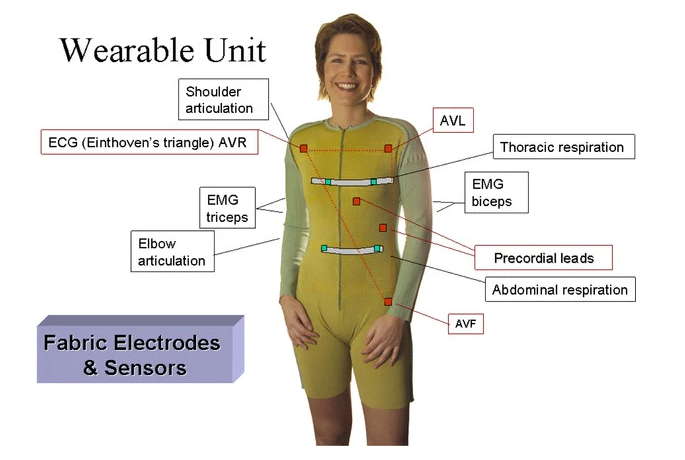The rise and adoption of wearable technology completely changed the healthcare industry by improving outcomes, enabling remote care, and even saving lives. The continuous evolution of patient-worn devices dictates how the next wearable sensors will be developed. These life-changing devices are now being utilized in diverse environments and scenarios, with many being at home or in public settings.

Source
Device designers and engineers must consider the challenges experienced by physicians, nurses, technicians, patients, and other healthcare professionals. To design wearable sensors that work efficiently in different settings for diverse needs, designers and engineers must consider the following:
- Weather (includes moisture and temperature)
- Abuse (e.g., oil, acidity, bleach, rugged use)
- The ambulatory nature of the user
These challenges are the standard ways a user behaves, which may affect wearable sensors' effectiveness and durability. These usually happen outside the clinical setting. Understanding the users and their environment is critical for device success. Here are a few things to keep in mind if you’re looking to develop a wearable or smart sensor.
Device adoption
Device adoption is considered one of the most crucial steps since sales will suffer without this, and your wearable sensor will not reach target users. Potential users won’t like a device that’s difficult to operate in the home or a public setting. They could proceed to turn it off, leave it behind, or take it off, and no nurse or doctor will be there to put it on or turn it back on.
The users you are targeting with wearable sensors need to figure out how to use them easily. Regardless of initial training from a caregiver, they most likely need to figure things out for themselves when they are on their own and have an issue. You need to target the device features so they can be understood and efficiently operated by your target users.
You need to keep in mind the concerns of the user. For example, teenagers with diabetes don’t want to be seen checking their glucose because it makes them different from their friends. A device that measures glucose automatically is an advantage, but it may be a problem if it is visible to others.
Research
Ethnographic research is the general way of accomplishing this. An ethnography is an observational step wherein the developer or researcher observes users interacting with the device or situation to learn about the product’s interaction. Ethnographic research is typically accomplished during product development and utilized in early formative studies. Finding usability data from the beginning and showing how the design fulfilled the user need results in the following:
- Input to dictate the design of the device;
- Design a device that users won’t stop using;
- Creates a formative study to supplement FDA submission.
Keep in mind that you don’t want to simply ask people if they would use the device you have in mind. Henry Ford said his customers would say they just wanted faster horses. Understand the problems your customers have. If you can make their lives better, you are likely to have a successful product.
Action plan
Here is a helpful design checklist for wearable devices that includes sensors. When Voler Systems develops a device, they consider all of these factors. Often, engineering judgment is used to evaluate the trade-off between size, cost, testability, and manufacturability of the device.
Want to learn more?
- Innovation Trends for Sensors and Wearable Devices
- Wearable Sensors and Batteries
- How Does Sensor Data Go from Device to Cloud
Other resources:
In the article, Human Factors and Ergonomics Society, Vivian Genaro Motti and Kelly Caine talked about the great potential of wearable devices to support several application domains ranging from medical and safety-critical to leisure and entertainment. They agreed that the human aspects are often neglected, which can decrease the acceptance levels for novel devices and their sustained engagement. They then proceeded to define a list of 20 human-centered design principles. Check out the article here.
Are you developing wearable sensors?
It’s easy to underinvest in design and security to keep your product affordable; however, this can lead to catastrophic device failure, added costs, slow transfer to manufacturing, or even project failure. Utilizing a well-design device and integrating security during the development stage adds cost and time to the development, but building IoT devices with robust design and security features can result in better productivity, legal compliance, enhanced reputation, and financial savings.
You can entrust your sensor-based wearable products to Voler's expert low-power design team. Voler's experts combine decades of electronic design experience on hundreds of projects across a wide spectrum of sensors, power, and wireless communication. We are sensor experts and have developed many wearable technology products and medical devices by managing the design trade-offs between size, power, and cost. We select the best wireless standard for your application. Voler Systems offer services critical for successful medical device projects. Voler can kickstart prototypes or jump into any stage of product development while meeting tight development schedules and budgets.
Sensor-based wearable products are revolutionizing how healthcare is delivered, and we can expect to see this growth continue into the future.
Here’s a testimonial from Voler System’s customer of 6 years.

About Voler
Located in Silicon Valley and with more than 40 years of electronic design experience, Voler Systems continues to be a leading custom product design consulting company providing highly experienced electrical engineers and firmware developers. Voler Systems ensures delivery of quality products, on time, on budget, and with low risk. All projects are undertaken with good specifications, the right people, quality design, constant communication, and a smooth transfer to manufacturing.